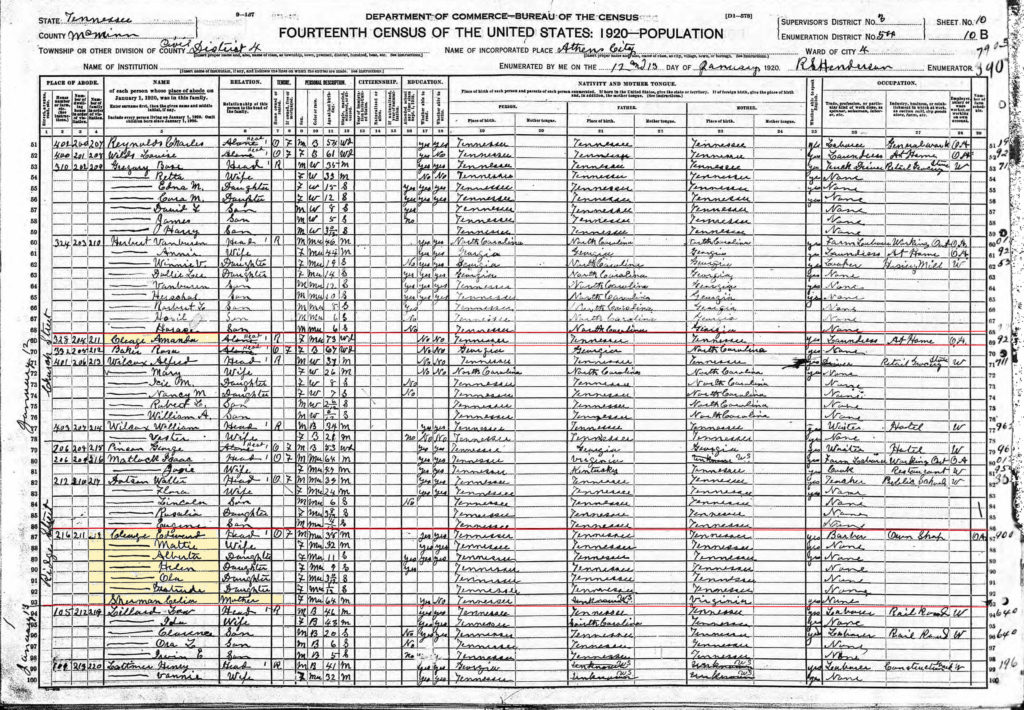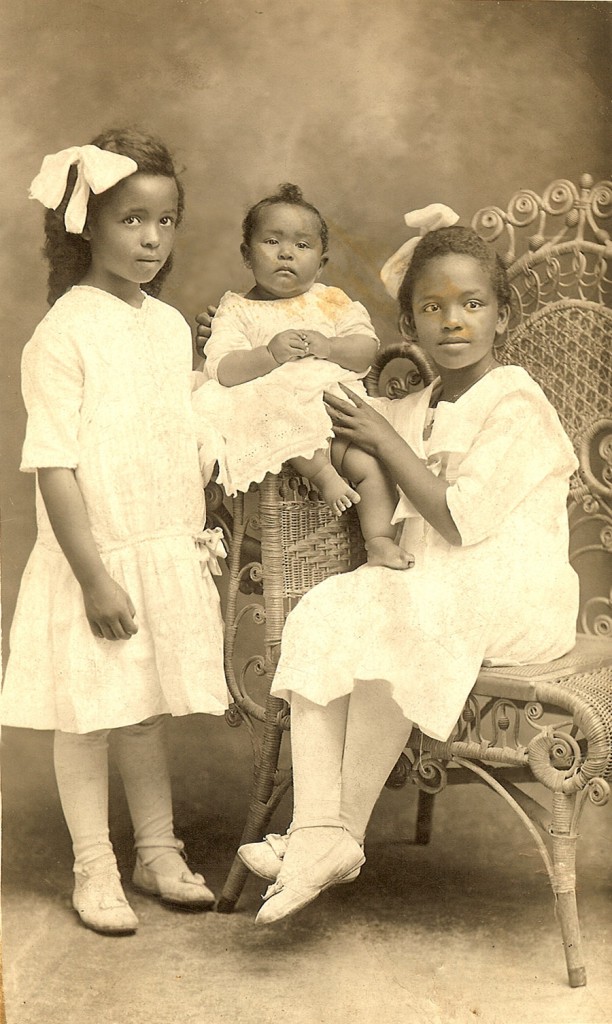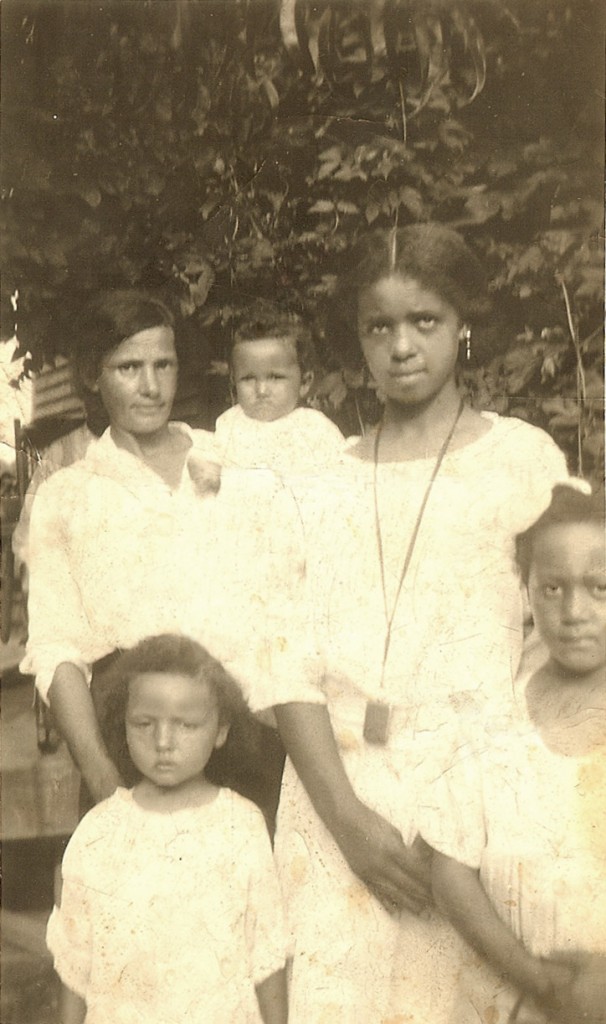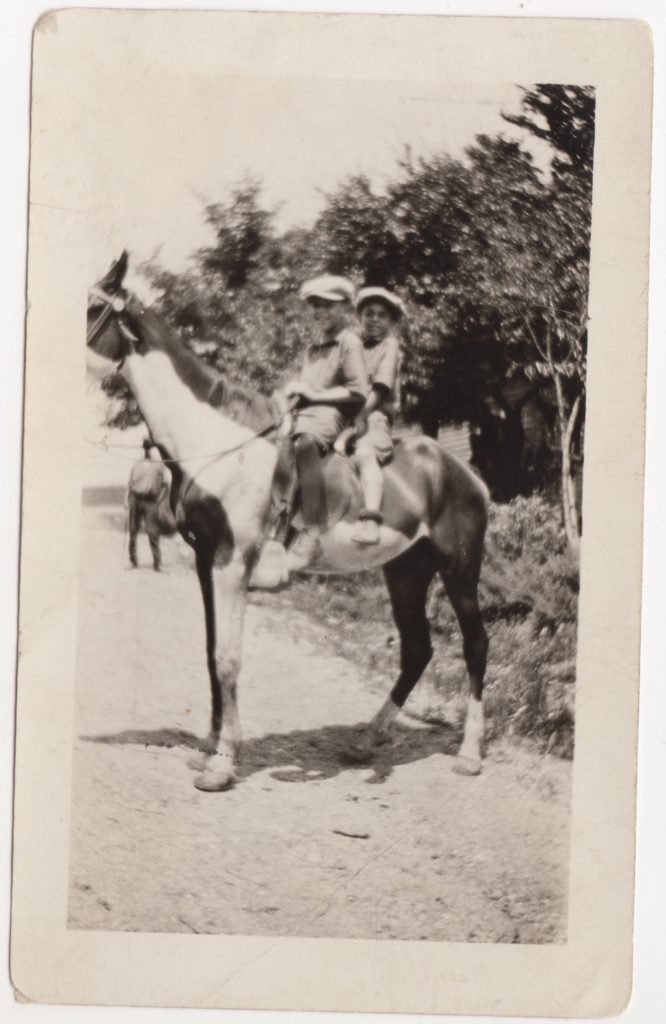

In 1920 my great grandmother Celia Rice Cleage Sherman lived with her son Edward and his family in Athens, Tennessee. She was 64 years old and could read but not write. She was not working for pay. She was married but her husband was living in North Carolina with his daughter. By June he was dead of tuberculosis of the bowels, apparently a difficult disease to diagnose and treat.
Edward Cleage was the head of the household. He was 38 years old, literate, owned his own house and was a barber operating his own shop. Mattie Dotson, his wife, was 32 years old. She was literate and did not work outside of the home. They had four daughters, Alberta 11 and Helen 9 were attending school. Ola was 3 and a half and the baby, Gertrude Beatrice was only a month old.
Mattie’s brother Walter Dotson and his family lived next door. He was 39 and taught in the public school. He also owned his own home free of mortgage. His wife Flora did not work outside of the home. They had three children, Lincoln who was 6, Rosalia was 3 8/12 and Eugene was 4/12. Both households were described as “mulatto.
On this same census page there were seven older people who lived alone because of being widows or widowers. One of them was Amanda Cleage, a widow who at 73 was still supporting herself as a laundress from her home. She rented her place and was unable to read or write. I feel that I know Amanda quite well after doing an in depth investigation of her a year or so ago. It was like seeing an old friend to find her one of my great grandmother’s neighbors.
William Wilcox and his neighbor George Pinson were both identified as black. Both worked as hotel waiters for wages. Both were literate. George Pinson was a widower. William Wilcox’s wife, Vester did not work outside of the home.
Herbert Vanburen and his wife Annie rented their home. He worked as a far laborer on his own account and Annie Vanburen took in laundry. They had seven children. The oldest, Winnie was 19 and was a looper at a hosery mill. A looper was given a finished sock without the toe portion. She placed it into a machine that would attach the toe using several needles and thread, and it would come out looking as if the whole sock was one piece.
The next four children, ages 14 to 8 attended school. The youngest two were six year old twins and not yet in school. Everyone who was old enough was literate and everybody was described as mulatto.
Other single people were 67 year old Rosa Baker who was a widow, illiterate and did not have employment. Charles Reynolds owned his house free of mortgage, was literate and did general laboring on his own account. He was 54. Louise Wilds was 61, a widow and could read but not write. She took in laundry on her own account. They were all described as black.
Forty six year old Low and his wife Ida Lillard, forty three, lived on the other side of the Cleages. They rented their house. He could read but not write. She was literate. Low and his oldest son, twenty year old Clarence both worked as laborers on the railroad. The two youngest children were six and five, too young for school. The family was described as black.
Henry Lattimer was 41 and worked as a laborer in construction. His wife Vonnie was 32 and did not work outside of the home. They were both literate. He was described as black. Vonnie and the six children were described as mulatto. The oldest son, Leake, was 19 and like his father worked as a construction laborer. Sixteen year old Cleona had attended school in the past year was literate and worked as a knitter at a hosiery Mill. The 10 year old and 7 year old attended school. The two youngest were under three.
There were two white families living nearby. Both of them rented. Bose Gregary was literate, although his wife was not. He worked as a driver for a grocery store. His wife didn’t work outside of the home. Their oldest three children attended school. The younger two were too young.
Alfred Wilcox was also white. He and his wife were not literate. He also worked as a driver for a grocery store for wages. I wonder if the two families were connected, but I am running late here with no time to look into that. His wife didn’t work outside of the home. They had four children. The oldest were 8 and 7 and not yet in school. The youngest two were under three.






That studio photo is so pretty!
Also, apparently I had relatives in the US in 1920, so maybe I should look into the census too…
The Multicolored Diary
You should really do that! Let me know if I can help. kcleage@gmail.com
Those photos are wonderful and Tarkabarka is right – the studio photo is so very pretty.
So much information in one page.
Tasha 💖
Virginia’s Parlour – The Manor (Adult concepts – nothing explicit in posts)
Tasha’s Thinkings – Vampire Drabbles
That is one of my favorite family photos.
It was lovely to read how you felt when you discovered that Amanda Cleage was your great grandmother’s neighbour.
Looper, learnt about a new word and a new skill today. Never thought that toes would be added to socks separately!
I have been researching all those who came off of the same Cleage plantations that my Cleage ancestors came off of. Amanda and her husband Abraham Cleage were one such couple. I love to see the community criss cross and intersect with each other.
I know! When I saw that she was a looper, I had no idea what that was, so I googled it. There were so many very young children doing that and other work in the mills at that time. Younger than the two young women on this census page were, 8 and 9 years old.
Were she and her husband separated by choice, or just living long-distance for work or whatever?
Black and White (Words and Pictures)
In March of 1912 he was still in Athens working on the funeral bills of Celia’s mother, Susan Ragan who was the widow of a member of the United States Colored Troops. In 1920, W.R. Sherman was 75 years old, dying of tuberculous of the bowels at his daughters home in Winston Salem, North Carolina. I don’t know how long he was there, if his daughter came and got him because he was ill and she thought she could care for him better or get better treatment for him there. His death certificate says he was married. On the census both Sherman and Celia say they were married. That is all I know.
Another interesting chapter and to see the documents and photos makes this story even better.
I am glad you enjoyed it! It was the first post of this A to Z season that I had absolutely nothing written until yesterday. Whew. Tomorrow’s post turned out to be the same. I have to go check now and see if I have more like that!
I really enjoyed this post. First, thinking of the your great-grandmother Cleage living with her son and his family (right?) and all those lovely girls. What great expressions. I love that little Ola!
I need a looper right now to replace all the toes of my socks!
Would Amanda Cleage have been related to you or was she one of the unrelated Cleages you have researched?
Finally, I really love it when you go through every household on a stress and figure out who they are, what they do for a living, whether they own their own home, and whether they are related to each other. It reminds me of the British writer Pat Barkers first novel (or collection of linked short stories), Union Street–set in the North of England in an area of high unemployment–in which she tells the stories about people living in the various houses on the street and slowly as you get to know the whole cast of characters some of their stories start t overlap.
Yes, she was living with her son Edward and his family. He is the only one who remained in Athens. Her other four children moved north, eventually all ending up in Detroit.
Amanda Cleage was not related to me. One of her great grand something nieces and I are present day friends on facebook. We met before I did all that research, thinking that being Cleages, we must be related.
I like when the stories overlap too. It provides some depth to their stories that’s missing when you just know the individuals.
I’m astounded by how many great photos survive. Someone did a great job of taking care of them.
My Cleage photos were in a box! The Graham photos were glued in an album with muslege and Scotch tape! It’s amazing they survived.
Interesting study of a single census page — amazing what family details you were able to find! Also fascinating to learn about hosiery loopers, an occupation I was unaware of.
All that information about the neighbors is right there on the page. I didn’t have time to look further.
Kristin, again you’ve brought a local family history to life! Thank you for sharing. I love your research.
Even such a quick glimpse into these people life is so fascinating.
And I’m not surprised you were interested in Amanda. I never imagined such a old woman (and she must have been quite old in the 1920s) could not only live, but even support herself, with no help. She must have had such a personality!
@JazzFeathers
The Old Shelter – Living the Twenties